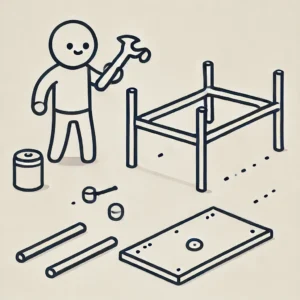Have you ever been in a company where everybody keeps working harder and harder, and yet everything is getting slower and more congested? And there’s always one team that seems to be the problem!
If so, you might be experiencing the Theory of Constraints in action.
I’ll never forget my talk with a tech CEO where I worked. When we started talking, I thought he got it. He talked about how much time they spent working on their process bottlenecks.
So I continued…
Me: “So if you’re producing more at a non-bottleneck, it slows down the bottleneck because they end up doing work that isn’t producing value.”
CEO: “Absolutely, I get it, I get it.”
Me: “So if we want to go faster, we actually want some people to do less work.”
CEO: “Yeah, that doesn’t work for me, I want everybody putting in 100%.”
Me: “But that… will make the overall production of the company slower and more expensive, right?”
CEO: “Yeah, but having people sitting around… that just doesn’t work for me.”
This implication of the theory of constraints go against our intuition, and sometimes our values.
But let’s investigate what happens when everyone is cranking at 100%.
What happens when everyone is working 100%?
Overproducing in non-bottlenecks does not simply create a backlog for the bottleneck, but slows down performance at the bottleneck.
What happens if I am doing exactly as much work as I can do, and the amount of work I can do is coming to me at the pace I can do it?
I am simply doing the work as it shows up. I take the work and I do it, and then it’s done. I don’t have to think too hard, I just do the work. There’s very little work management.

But what happens if I am getting a bit more work than I can do?
Suddenly I need a system to organize the inventory of work (parts that I’ll use, work orders, etc).
The extra work, by simply being extra, has just created the need for a management system.

Now I’m doing the work AND managing the work to be done.
I am already slower!
The mere fact of having too much work causes a problem.
As one bottleneck piles up, other parts of the system also get backed up! Now we need sophisticated management!
In physical space, this amounts to warehouses. That makes the problem easy to detect, and therefore avoid (if one is conscious it’s a problem).
In virtual space, it amounts to confusion and reprocessing things that have been processed to see if they’re now ready for work, or should be prioritized.
Warehouses need increasing sophistication to manage more inventory, just like knowledge work. And if that system is not in place, things get dropped. People lose track of what’s important.

When a team seems to be constantly drowning in designs and explorations and questions and requests that never gets turned into implementation, this is likely what’s happening.
Upstream teams are overproducing. Work piles up. Increasingly sophisticated management is required, which inevitably pulls team resources away from delivering work.
The entire situation would be dramatically improved by having half the company sit on their hands and do nothing.
But hey, we don’t want people just sitting around! We’re paid too much to sit around!
Usually, the source of the problem is missed, and instead of looking at systems, people look at people, and typical unproductive patterns emerge. Finger-pointing, scapegoating, etc.
All the extra work creating work to be done (that can’t be finished) is likely money gone forever. It’s knowledge work and knowledge work requires someone’s headspace to stay relevant. So it dies on the vine, and continues to exist as clutter.
This clutter overshadows the core problems, as the clutter itself becomes a problem.
This in turn, exacerbates a lack of focus.
Then you get a morale problem, and some in-fighting, and people start to get burnt out when it’s hard to see how they can possibly win.
The Team at the Bottleneck
In our warehouse example, if the person making the tables was asked, he’d say he had way too much work to do. Things are backing up.
The teams making table tops and table legs, on the other hand, have plenty of capacity. They have so much time and space they even have time to improve the efficiency of their production processes.
“We’ve increased our output by 100% over the last year, and reduced costs! We’re making more table legs and tops than ever!”
A naive management, unaware of the Theory of Constraints, might even reward them for creating so many extra parts.
This same management may even identify a problem, that not enough tables are being assembled by the Assembly team.
They may then try to figure out why, and might look at the people making the tables. Maybe the problem is the people making the tables. They’re the ones getting more and more behind, after all. Not getting further and further ahead, like our Legs and Tops teams.
The narrative that the Assembly team is having trouble, or doesn’t know what it’s doing, or isn’t prioritizing properly, is likely to occur.
But the Assembly team, until they can stop being the bottleneck, is essentially hopeless in this situation to change the narrative.
This seems terribly silly perhaps, because it is.
But this kind of thing happens in knowledge work all the time. It is because there is no visualization of flow across complex product development. The interdependencies of work are generally not well understood. The impact of scheduling exploration meetings with team members for work that won’t ever happen is not noticed.
Essentially, all the work is invisible.
Why do we work in ways that don’t work?
People don’t do what makes sense based on the situation. They do what makes sense based on how the situation occurs to them.
The laziest analysis is usually “They’re not doing a very good job” which immediately becomes “It must be because they’re not very good” or “They don’t know what they’re doing.”
While you might think that some level of intelligence would preclude you from arriving at these conclusions, you’d be wrong.
Our perceptions are informed by theory, and most of us have a theory that People produce results through their effort and dedication.
This is true, but when you have everyone in a system, that is no longer strictly true.
In systems, people produce results through the correct application in the right place of their efforts and dedication.
Not all work increases the output of the system.
Local optimizations are system-wide degradations, unless it’s optimizing the bottleneck.
If we misidentify the problem, we will waste even more effort on things that make no difference.
Rather than increased efforts, we need measurements and clarity, so that we can identify and focus on what will make the difference.
Until you can measure or at least observe results, you can’t get away from the typical dynamics of needing to look like you’re working hard.
If you could ask one question that would make the difference: How do we know when things are working?
Pingback: Dealing with Bottlenecks | Max Summe